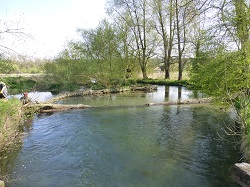Flooding is a natural part of the river cycle, rivers are not meant to be contained and connectivity with the floodplain attenuates water
Unfortunately, many people are at risk from river flooding in the Thames river basin due to homes, buildings and infrastructure being constructed on floodplains. Many traditional, hard engineering schemes are in place to help protect people and property but they are not guaranteed to prevent all river flooding. Part of the solution is to make more space for flood waters and to slow the flow of rivers at times of high rainfall. These objectives can be helped by the use of Natural Flood Management (NFM) techniques such as creating or restoring floodplains, constructing leaky dams, providing overspill areas and planting trees on slopes, especially on the tributary rivers and headwaters. All of these techniques also improve rivers for wildlife.
NFM catchment and community schemes announcement
Flood Minister Therese Coffey’s announced the successful Natural Flood Management bids on 14th July 2017 whilst at SERT’s SuDS in Sutton Schools project. The allocation of this new funding will enable 24 catchment and 34 community schemes all over the country to deliver increased flood protection through a range of measures.
“Methods such as restoring floodplains and planting trees will not only help protect families, homes and businesses from flooding, they will also bring environmental benefits to the wider area and all the people who live in these many communities”, said Minister Coffey.
The Thames catchment has 12 successful projects in the community schemes, well done to all of them!
And 3 successful projects in the catchment scheme:
Pilot Scheme
The first pilot catchment for NFM in the Thames region is on the River Evenlode and the Cotswold Rivers Trust is a partner in this. Our Thames Restoration Fund has granted £25k to Cotswolds Rivers Trust for its Pudlicote Phase 2 project. The latest briefing notes on the Evenlode Natural Flood Management scheme are here EvenlodeCaseStudy_170717 to download. TRT Trustee and RFCC Conservation Member Robert Oates has welcomed the publication, this is the first scheme of its kind in Thames region to test NFM measures across a whole sub-catchment to provide data on how much water may be held back and contribute to reducing flood risk.
Latest Report
The Thames Regional Flood and Coastal Committee (RFCC) has an important role to play in approving the flood risk management schemes of the EA, Lead Local Flood Authorities (LLFAs) and water companies (for sewer flooding), many of which have benefitted our rivers. The RFCC has now published a report for the period 2011-2017, which explains in detail what it does and how it operates. Over the period, the RFCC has developed a strong Natural Flood Management theme, which includes promoting SuDS and floodplain and river restoration. That theme is reflected in the RFCC’s ’25 Year Approach’ which is included in the report. The report can be downloaded here Thames RFCC Perodic Report.

Award winning rain garden by Wendy Allen

Slowing the flow with large woody debris (LWD)





